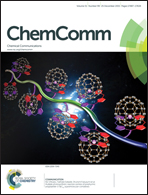Sequence-selective DNA recognition and enhanced cellular up-take by peptide–steroid conjugates†
Abstract
Several GCN4 bZIP TF models have previously been designed and synthesized. However, the synthetic routes towards these constructs are typically tedious and difficult. We here describe the substitution of the Leucine zipper domain of the protein by a deoxycholic acid derivative appending the two GCN4 binding region peptides through an optimized double azide–alkyne cycloaddition click reaction. In addition to achieving sequence specific dsDNA binding, we have investigated the potential of these compounds to enter cells. Confocal microscopy and flow cytometry show the beneficial influence of the steroid on cell uptake. This unique synthetic model of the bZIP TF thus combines sequence specific dsDNA binding properties with enhanced cell-uptake. Given the unique properties of deoxycholic acid and the convergent nature of the synthesis, we believe this work represents a key achievement in the field of TF mimicry.


 Please wait while we load your content...
Please wait while we load your content...